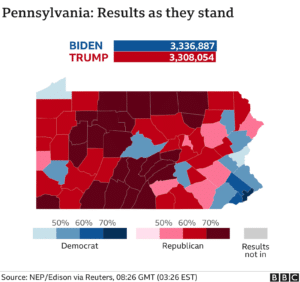‘Keystone State’ Pennsylvania will be the keystone of the 2024 election

by Rylee Napolitan, Women and Girls Foundation, Pennsylvania
The presidential debate on Sept. 10 between candidates Vice President Kamala Harris (D) and former President Donald Trump (R) taking place in Philadelphia was no happy accident. Pennsylvania has been fondly known as the Keystone State for its historical prominence in the founding of the United States, and that name still rings true in the present day.
A keystone is defined as, “the stone [that] holds all the other pieces in place — without it the arch would collapse.” Pennsylvania, while being the keystone for the original 13 colonies, has also played an instrumental role in the last few presidential elections.
The significance of Philadelphia being the stage for the presidential debate is in part due to this. On only 10 occasions in its entire voting history has Pennsylvania voted for the losing candidate. In the last two presidential elections, Pennsylvania has even pushed each candidate to victory by a slim margin of votes.
Pennsylvania is what’s known as a “purple state,” or a swing state. While states like California and New York are almost always guaranteed to vote blue and states like Texas and Florida are apt to vote red, Pennsylvania voters tend to “swing” back and forth between Democratic and Republican candidates.
In spite of where it falls in determining the presidential vote, the voting demographics remain consistent in specific areas. Pennsylvania is a larger state than it appears, and while urban areas in the state — particularly those concentrated in Eastern PA and Allegheny County in Western PA — are almost always blue, the remainder of the population — which largely consists of rural voters — votes red.

It is because of this that the presidential debate is certainly not the first and definitely won’t be the last time we see both candidates campaigning in Pennsylvania. Both Harris and Trump know that Pennsylvania is one of few states that will determine the result of the election this November, turning it into a metaphorical battleground.
It was a calculated move, for instance, that Trump selected to hold a rally on July 13 in Butler County, which ended up being the site of the assassination attempt against him. Just as it’s been a calculated move for the Harris/Walz campaign tour to make several stops in different locations across the state, with promises to return in the remaining month and a half leading up to the election. Harris even spent the days leading up to the debate in Pittsburgh.
As Pennsylvania voters continue to gear up for the election this November, it has become quite clear: those who show up to the polls and cast their vote will play a huge role in determining the results of the election. One of many arguments that people use to rationalize their reasoning for not showing up to the polls is the idea that “just one vote” does not matter. But in swing states like Pennsylvania, the importance of the vote is further amplified, as your singular vote plays a part in something bigger that could determine the course of the next four years — and beyond — in our nation.
To register to vote for the election, you can visit: www.pa.gov/en/agencies/vote/voter-registration.html. Oct. 21 is the last day to register to vote in Pennsylvania in order to be eligible to vote in the election on Nov. 5.